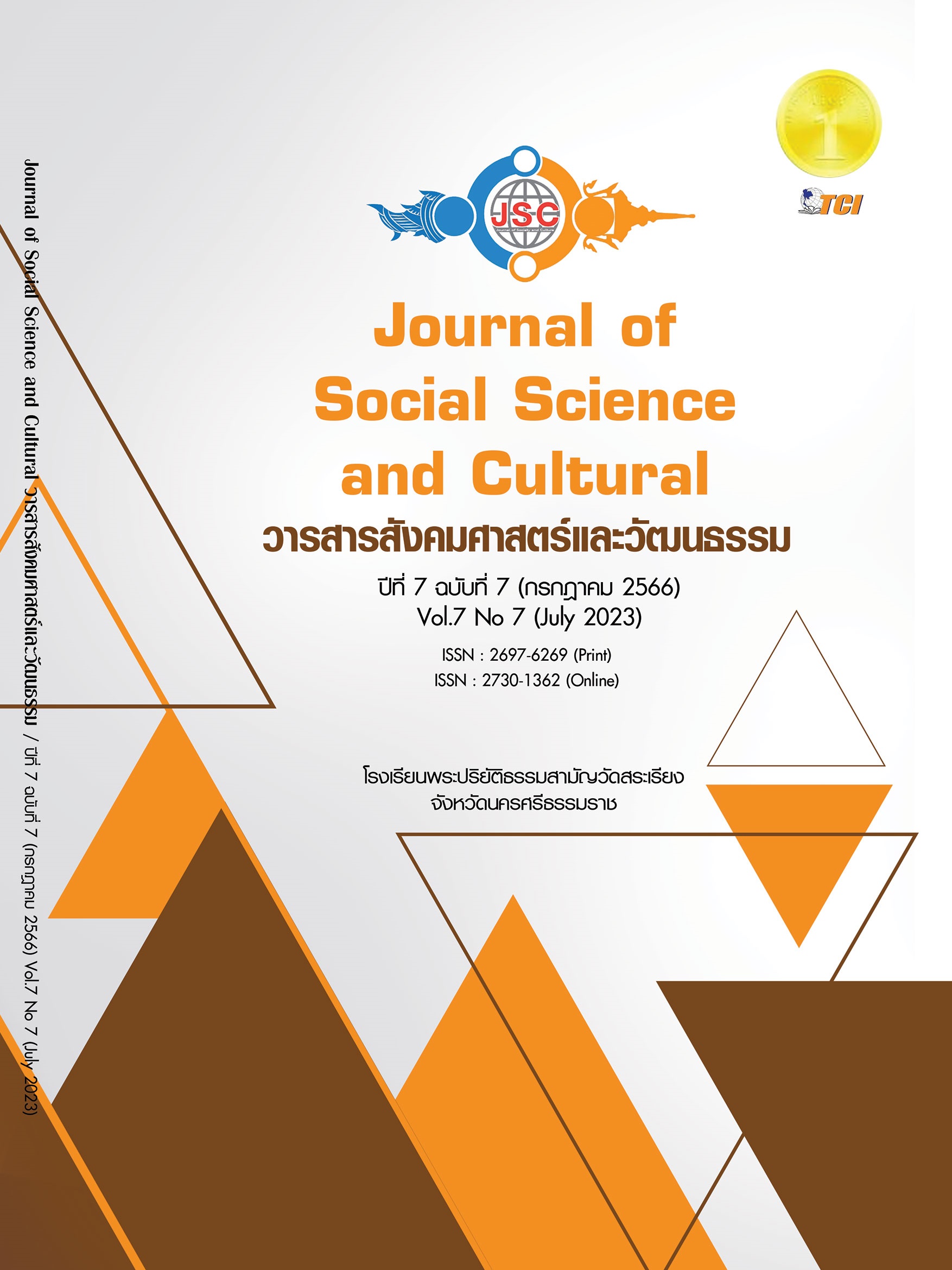THE DEVELOPMENT OF MOVEMENT SKILLS IN PATIENTS WITH PARKINSON’S DISEASE BY USING THE DANCE THERAPY ACTIVITIES ACCORDING TO LSVT BIG THEORY
Main Article Content
Abstract
This research is the development of movement skills in patients with Parkinson's disease by using the dance therapy activities according to LSVT BIG. To design an activity set and to study the results of using the LSVT BIG theoretical behavioral therapy activity among patients with Parkinson's disease. From the development research. To develop art treatment activity and the experiment research. By conducting studies in Parkinson's patients, a total of eight people. The results of the study concluded that the series of dance therapy activities has the application of a vocal character that has a characteristic from northeast dance. With a particular emphasis on balance, there is a wide and large movement that is consistent with the LSVT BIG theory. In every position, the activity is divided into one main activity and three sub-activities, as follows: main activity, LSVT BIG theoretical dance therapy, and an activity set to develop movement skills in patients with Parkinson's disease. From the northeast dance moves that correlated with LSVT BIG theory are arranged from the process. The posture starts from the upper part of the body. Then, every part of the body, as previously mentioned, causing the practitioner to use force and concentrate on high movement use. The duration of the activity was four weeks, four times in total, 16 times at 60 minutes each. According to the t-test for statistical analysis, the Five Time sit to stand test had an average before joining the activity at 17.89 seconds and after joining the activity at 12.59 seconds. It took less time than before the trial. The activity set had an average difference of 5.30 seconds, and time up and go test tests had an average before joining the activity at 16.87 seconds and after joining at 10.94 seconds. The duration was less than before the trial. The activity set had an average difference of 5.93 seconds.
Article Details
References
กรมกิจการผู้สูงอายุ. (2565). ยุทธศาสตร์กรมกิจการผู้สูงอายุ 20 ปี ประจำ ปี พ.ศ. 2561 – 2580. กระทรวงการพัฒนาสังคมและความมั่นคงของมนุษย์. เรียกใช้เมื่อ 8 กรกฎาคม 2565 จาก https://www.dop.go.th /download/knowledge/th1539326153-138_0.pdf
จุฑาทิพย์ รอดสูงเนิน. (2564). ผลของโปรแกรมการออกกำลังกายที่มีต่อการทรงตัวและความกลัวการล้มของผู้สูงอายุในชุมชน. วารสารศูนย์อนามัยที่ 9, 15(15), 541-560.
ชลาลัย วงศ์อารีย์. (2561). แนวทางการจัดกิจกรรมด้านศิลปวัฒนธรรมพื้นบ้านเพื่อส่งเสริมสุขภาพผู้สูงอายุ. วารสารชุมชนวิจัย มหาวิทยาลัยราชภัฏนครราชสีมา, 12(ฉบับพิเศษ), 169-184.
ชัยพัฒน์ ศรีรักษา และคณะ. (2561). ผลของการรำเซิ้งอีสานต่อสมรรถภาพทางกายในผู้สูงอายุชาวไทย: การศึกษานำร่อง. จุฬาลงกรณ์เวชสาร, 62(2), 211-222.
ธนวัฒน์ อิ่มภักดิ์, ธีร์ธานิศ พันธ์นิกุล, & พัชรี วงษาสน. (2022). ผลของการฝึกการยืดเหยียดแบบพีเอ็นเอฟที่มีต่อพิสัยของข้อต่อในนักศึกษาชาย สาขาวิทยาศาสตร์การกีฬา ชั้นปีที่ 1 มหาวิทยาลัยราชภัฏมหาสารคาม. วารสารวิทยาศาสตร์การกีฬาและนวัตกรรมสุขภาพ กลุ่มมหาวิทยาลัยราชภัฏแห่งประเทศไทย, 1(3), 44-51.
นริศรา ศรีสุพล. (2558). การสร้างสรรค์นาฏศิลป์ พื้นเมืองจากวรรณกรรมเรื่องอุสาบารสในบริบทวัฒนธรรม. วารสารสถาบันวัฒนธรรมและศิลปะ มหาวิทยาลัยศรีนครินทรวิโรฒ, 17(1), 76-83.
ปิยะนุช รักพาณิชย์. (2562). ฟื้นฟูสมรรถภาพและกายภาพบำบัดแบบผสมผสาน. การฟื้นฟูผู้ป่วยที่มีปัญหาทางระบบสมองและระบบประสาทแบบผสมผสาน. เรียกใช้เมื่อ 8 กรกฎาคม 2565 จาก http://arunhealthgarden.com/lsvt-big-การออกกำลังกายแนวใหม่/4176/.
ระวิวรรณ วรรณวิไชย. (2554). นาฏยศิลป์ เพื่อเด็กที่มีความบกพร่องทางการได้ยิน. ใน ดุษฎีนิพนธ์ศิลปกรรมศาสตรดุษฎีบัณฑิต สาขาวิชาศิลปกรรมศาสตร์. จุฬาลงกรณ์มหาวิทยาลัย.
รุ่งโรจน์ พิทยศิริ. (2554). Practical movement disorders (พิมพ์ครั้งที่ 1). กรุงเทพมหานคร: ศูนย์รักษาโรคพาร์กินสันและกลุ่มโรคความเคลื่อนไหวผิดปกติ โรงพยาบาลจุฬาลงกรณ์.
วิมลศรี อุปรมัย. (2524). นาฎกรรมและการละคร : หลักการบริหารและการจัดการแสดง. กรุงเทพมหานคร: เคล็ดไทย.
วิสาขา แซ่อุ้ย และระวิวรรณ วรรณวิไชย. (2559). การเคลื่อนไหวบำบัด : กิจกรรมพัฒนาผู้สูงอายุ. วารสาริลปกรรมศาสตร์ จุฬาลงกรณ์มหาวิทยาลัย, 3(2), 1-12.
ศุภฤกษ์ นาวารัตน์. (2547). ออกกำลังกายทางเลือกเพื่อคุณภาพชีวิตที่ดีของพาร์กินสัน. แพทย์ทางเลือก, 4(37), 58-59.
สมาคมกลุ่มโรคความเคลื่อนไหวผิดปกติ(MDS). (2551). แบบประเมิน UPDRS ฉบับใหม่(MDS UPDRS). เรียกใช้เมื่อ 2 ธันวาคม 2563 จาก https://www.movementdisorders.org/MDS-Files1/Education/Rating-Scales/ MDS-UPDRS_Thai_OfficialTranslation_Final.pdf.
อมรา กล่ำเจริญ. (2542). สุนทรียนาฏศิลป์ไทย (พิมพ์ครั้งที่ 3). กรุงเทพมหานคร: โอเดียนสโตร์.
Fırat, Y. E. et al. (2023). Effects of LSVT-BIG via telerehabilitation on non-motor and motor symptoms and quality of life in Parkinson's disease. Acta Neurol Belg, 123(1), 207-214.
Janyacharoen, T. et al. (2013). Physical performance in recently aged adults after 6 weeks traditional Thai dance: a randomized controlled trial. Clin Interv Aging, 2013(8), 855-859.
Peterka, M. et al. (2020). LSVT-BIG therapy in Parkinson's disease: physiological evidence for proprioceptive recalibration. BMC Neurol, 20(1), 276. https://doi.org/10.1186/s12883-020-01858-2 .


